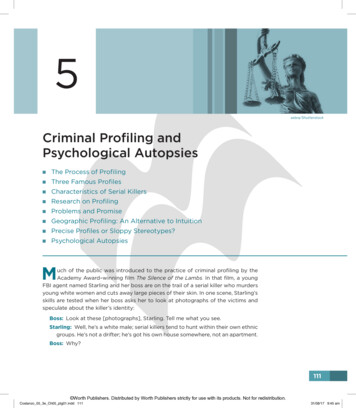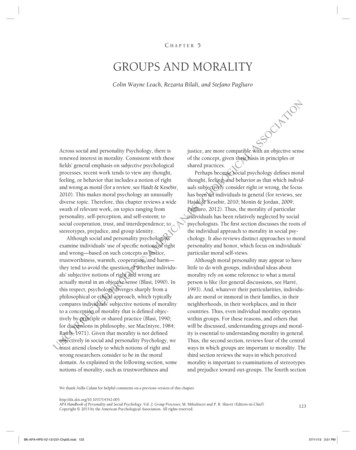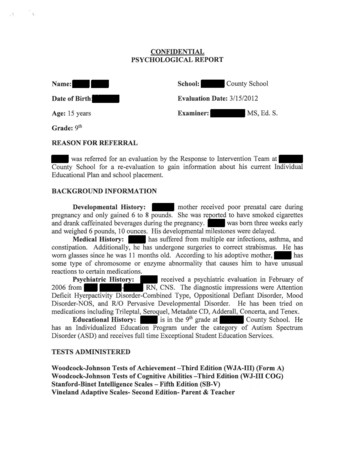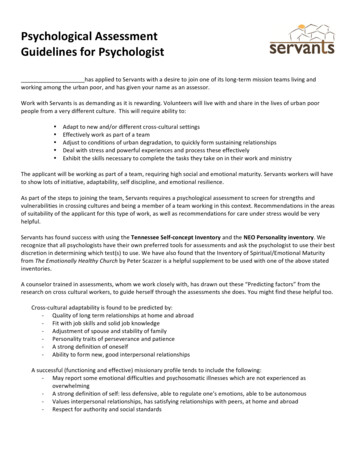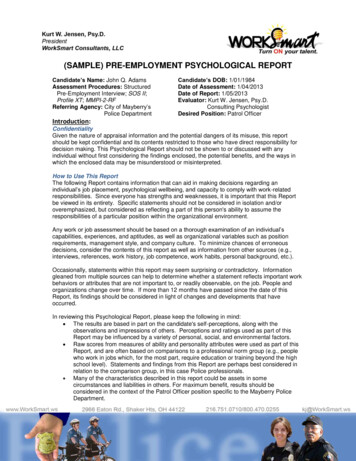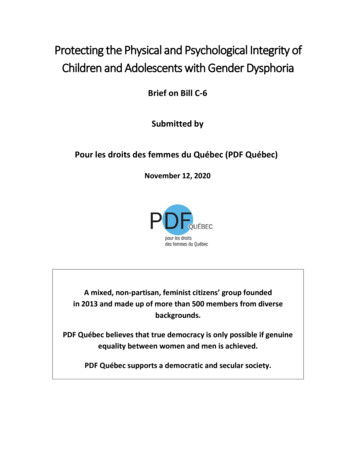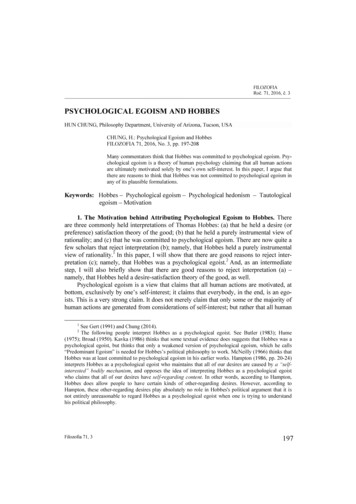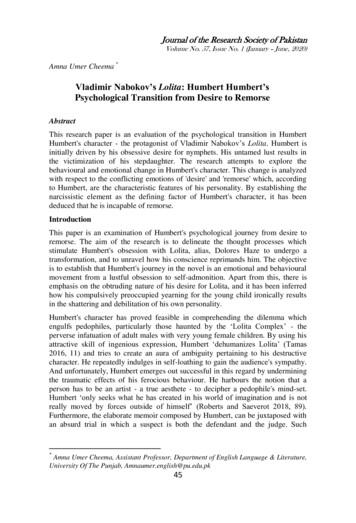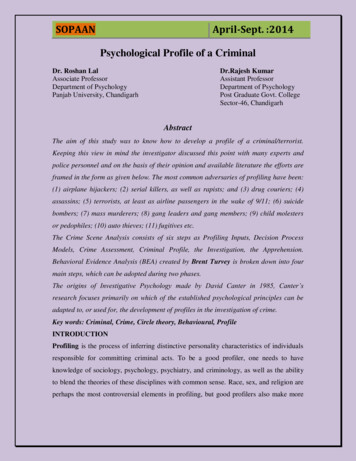
Transcription
SOPAANApril-Sept. :2014Psychological Profile of a CriminalDr. Roshan LalAssociate ProfessorDepartment of PsychologyPanjab University, ChandigarhDr.Rajesh KumarAssistant ProfessorDepartment of PsychologyPost Graduate Govt. CollegeSector-46, ChandigarhAbstractThe aim of this study was to know how to develop a profile of a criminal/terrorist.Keeping this view in mind the investigator discussed this point with many experts andpolice personnel and on the basis of their opinion and available literature the efforts areframed in the form as given below. The most common adversaries of profiling have been:(1) airplane hijackers; (2) serial killers, as well as rapists; and (3) drug couriers; (4)assassins; (5) terrorists, at least as airline passengers in the wake of 9/11; (6) suicidebombers; (7) mass murderers; (8) gang leaders and gang members; (9) child molestersor pedophiles; (10) auto thieves; (11) fugitives etc.The Crime Scene Analysis consists of six steps as Profiling Inputs, Decision ProcessModels, Crime Assessment, Criminal Profile, the Investigation, the Apprehension.Behavioral Evidence Analysis (BEA) created by Brent Turvey is broken down into fourmain steps, which can be adopted during two phases.The origins of Investigative Psychology made by David Canter in 1985, Canter’sresearch focuses primarily on which of the established psychological principles can beadapted to, or used for, the development of profiles in the investigation of crime.Key words: Criminal, Crime, Circle theory, Behavioural, ProfileINTRODUCTIONProfiling is the process of inferring distinctive personality characteristics of individualsresponsible for committing criminal acts. To be a good profiler, one needs to haveknowledge of sociology, psychology, psychiatry, and criminology, as well as the abilityto blend the theories of these disciplines with common sense. Race, sex, and religion areperhaps the most controversial elements in profiling, but good profilers also make more
SOPAANApril-Sept. :2014use of things like travel patterns, socioeconomic status, geographic locations, age, andclothing.COMMON ADVERSARIESThe most common adversaries of profiling have been: (1) airplane hijackers; (2) serialkillers, as well as rapists; and (3) drug couriers. To this list might be added: (4) assassins;(5) terrorists, at least as airline passengers in the wake of 9/11; (6) suicide bombers, aswell as bombers and arsonists in general; (7) mass murderers, especially those who"snap" and engage in workplace violence, or school violence; (8) gang leaders and gangmembers; (9) child molesters or pedophiles; (10) auto thieves; (11) fugitives; and (12) themost controversial one of all -- "racial profiling" which was a short-lived attempt to"spot" suspicious minorities who didn't seem to "fit" into the neighbourhood they weredriving, walking, or jogging in. The Lecture on Situational Awareness (in the HomelandSecurity course) provides the reader with a good background on non-serial killer profilingand also discusses three other adversaries: (13) stalkers; (14) abusers, as in domesticviolence; and (15) con men. Also, another adversary, (16) the white collar criminal, hasrecently emerged within the field of forensic accounting (see Lecture on Lifestyles ofFinancial Criminals).CRIMES SUITABLE FOR PROFILINGSadistic torture in sexual assaultsEviscerationsPostmortem cases of slashing and cuttingMotiveless fire settingsLust and mutilation murdersRapesOccult crimesChild sexual abuse including pedophiliaBank robberiesObscene and terrorist letter writing
SOPAANApril-Sept. :2014WHAT IS CRIMINAL PROFILINGCriminal profiling consists of analyzing a crime scene and using the information todetermine the identity of the perpetrator. While this doesn't directly give you theperpetrator's name, it is very helpful in narrowing down suspects. For example, a profilebased on a crime scene provides information that may include the perpetrator'spersonality, sex, age, ethnic background, and possible physical features such asdisfigurements or height and weight. This information can then be used to identifypossible suspects, depending on who fits the profile. Personality is one of the mostimportant parts of a criminal profile. "Behavior reflects personality. And that is whatprofiling is all about”.HOW DOES CRIMINAL PROFILING WORKPersonality profiles of criminals are based on the way in which a crime is committed, alsoknown as the 'method of operations' or m.o. The m.o. includes the identity of thevictim(s), what the victims (in the case of a serial offender) have in common, theweapon(s) used, the degree of hostility, the existence (or lack) of any torture and/orsexual molestation, and so on. Analyzing these aspects of the crime scene, an investigator(usually a trained forensic psychologist) can determine the motives of the perpetrator,which leads to a description of the perpetrator's personality, or the personality profile.THE CRIME SCENE ANALYSISThe Crime Scene Analysis consists of six steps, which are summarized in the section thatfollows:1. Profiling Inputs: This involves the collection and assessment of all of the materialsrelating to the specific case. This would typically involve any photographs taken of the, acomprehensive background check of the victim, autopsy protocols, other forensicexaminations relating to the crime, and any relevant information that is necessary toestablish an accurate picture about what occurred before, during or after the crime.2. Decision Process Models: This stage simply involves arranging all of the informationgathered in the previous stage (Profiling Inputs) into a logical and coherent pattern.
SOPAANApril-Sept. :20143. Crime Assessment: This stage would typically involve the reconstruction of thesequence of events and the specific behaviors of both the victim and perpetrator. Thiswill aid the analyst in understanding the "role" each individual has in the crime andshould assist in developing the subsequent profile of the criminal.4. Criminal Profile: the combined first three steps are used to create a criminal profileincorporating the motives, physical qualities, and personality of the perpetrator.5. The Investigation: Here, the actual profile is provided to requesting agencies andincorporated into their investigation.6. The Apprehension: unfortunately, this stage only occurs in about 50% of cases. Whena suspect is identified, he/she is interviewed, investigated, compared to the profile, etc. Ifthe investigators have reason to believe that the suspect is the perpetrator, a warrant isobtained for the arrest of the individual, usually followed by a trial with expert witnessesincluding the forensic psychologist and other forensic experts, including those involvedin the crime scene analysis.BEHAVIORAL EVIDENCE ANALYSISBehavioral Evidence Analysis (BEA) created by Brent Turvey is broken down into fourmain steps, which can be adopted during two phases. Firstly, those four steps of BEA willbe outlined, so the reader might develop ideas as to how they are used during the twophases.1. Equivocal Forensic Analysis: This step of BEA is called Equivocal Forensic Analysisbecause it is important for investigators to take into consideration that the physicalevidence can be interpreted in more than one way. This step is important because “onecannot render a thorough criminal profile until the physical evidence has been analyzedand interpreted”.The equivocal forensic analysis draws upon a variety of sources like: Crime scene photos, videos and sketches Investigators reports Evidence logs and evidence submission forms Autopsy reports, videos and photos Interviews of witnesses and neighbours
SOPAANApril-Sept. :2014 Any other relevant documentation, interviews, or information Map of the victims travel prior to death Background of the victim2. Victimology: It is recognized that the victim should be profiled in a similar fashion tothe perpetrator though historically, victimology has been one of the most neglected fieldsof criminal profiling. In the situation where you have a living victim, they may be therichest source of information relating to the perpetrator, though the involvement of thevictim is not to be discarded should they be killed during the incident.3. Crime Scene Characteristics: These are the “distinguishing features of a crime sceneas evidenced by an offender‟s behavioral decisions regarding the victim and the offenselocation, and their subsequent meaning to the offender”. This step involves thedetermination of a number of factors relevant to the location of the crime scene, wherethis crime scene is placed relative to other related crime scenes, and how the offenderapproached the victim/s. So the location of the crime scene in relation to the rest of theworld, the location of the majority of the offense occurred (the "primary crime scene"), aswell as the position of the body, etc., are used to figure out the criminal's motives, orwhat it meant to him or her.4. Offender Characteristics: It is this step which will contain the offender‟s behavioraland personality characteristics that are derived from, and informed by, the threepreceding steps. The offender characteristics may include such information as:Physical buildOffender sexWork status and habitsRemorse or guiltOffender vehicle typeCriminal historySkill levelAggressivenessOffender residence in relation to the crimeMedical historyMarital status
SOPAANApril-Sept. :2014RaceCollectively, this information will produce a "picture" of the offender, whichinvestigators may check off against known offenders, suspects, or suspect pools. Thismay produce further suspects, or may aid in reducing the amount of suspectsinvestigators are currently looking into.INVESTIGATIVE PSYCHOLOGYThe origins of Investigative Psychology can be traced back to 1985, when David Canterwas called to Scotland Yard to discuss the possibility of integrating investigationtechniques with psychological concepts. . Canter was unsure whether this could beaccomplished, but decided to apply some of the methods of environmental psychology tocriminal investigation, most notably the Railway Rapist.Canter‟s research focuses primarily on which of the established psychological principlescan be adapted to, or used for, the development of profiles in the investigation of crime.The application of Canter‟s work is based on five aspects of the interaction between thevictim and the offender, known as the five-factor model.1. Interpersonal Coherence: Refers to whether a variation in criminal activity will relateto variations in the way in which the offender deals with other people in non-criminalsituations.2. The Significance of Time and Place: May provide the analyst with information aboutmobility, and therefore guide inferences about likely residential location. As the time andplace of the event is largely chosen by the offender, this is seen to be important as it mayrepresent the way in which the offender views their surroundings.3. Criminal Characteristics: Used to allow researchers to develop subsystems for theclassification of offender groups, which may be used to provide characteristics toinvestigators that are likely to be possessed by the perpetrator in the current crime. TheFBI‟s classification of the offender as „organized‟ or disorganized‟ is one such systemused in identifying criminal characteristics, though Canter himself sees that this system isof little use considering there is so much overlap between the two classifications theoffender as „organized‟ or disorganized‟ is one such system used in identifying criminal
SOPAANApril-Sept. :2014characteristics, though Canter himself sees that this system is of little use consideringthere is so much overlap between the two classifications.4. Criminal Career: Simply refers to an assessment that is made to determine whetherthe offender may have engaged in criminal activity in the past, and what kind of activitythis is most likely to have been. It is closely related to the last concept, forensicawareness.5. Forensic Awareness: Is any evidence that an offender has knowledge of, or may beprivy to, police techniques and procedures relating to evidence collection.Canter developed a model of offender behavior known as the circle theory, whichdeveloped directly from environmental psychology. Two models of offender behaviorknown as the "marauder" and "commuter" hypothesis were developed from the circletheory. The marauder model assumes that an offender will "strike out" from their homebase in the commission of their crimes, whereas the commuter model assumes that anoffender will travel a distance from their home base before engaging in criminal activity.The "Marauder" (above) and the "Commuter" (below) models of offender behavior. Theoriginal study that was done to develop the model was retrospective, that is, used solvedcases where both the location of the offender‟s home and crimes were known. This mustbring the practical application of this model into question, as it would be practicallyimpossible to know whether you were dealing with a marauder or a commuter with anunknown offender. . The distances defined by the criminal range and home range are alsoproblematic, as there is no clear relationship between the size or location of the criminalrange and the distance it is from the offender‟s home.SOURCES OF THE CRIMINAL MOTIVEA person can feel controlled as a result of being poor, weak, unhealthy, small, ignorant,unimportant, or disrespected -- to name some common sources of the most commonmotive for crimes.Someone might be motivated to commit a crime (of revenge) because he was insulted [orsimply believed he was insulted] and therefore feels controlled (by the other person). He
SOPAANApril-Sept. :2014also might be motivated to commit a crime (of theft) because he is chronically envious ofwhat other people have and therefore feels controlled by societyCONCLUSIONA study in the field of behavioral psycholog
Criminal profiling consists of analyzing a crime scene and using the information to determine the identity of the perpetrator. While this doesn't directly give you the perpetrator's name, it is very helpful in narrowing down suspects. For example, a profile based on a crime scene provides information that may include the perpetrator's personality, sex, age, ethnic background, and possible .
